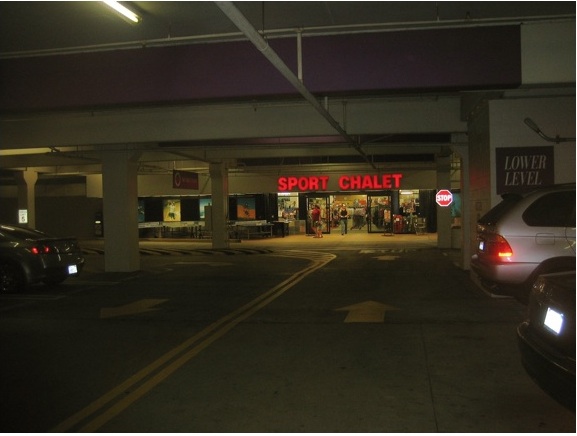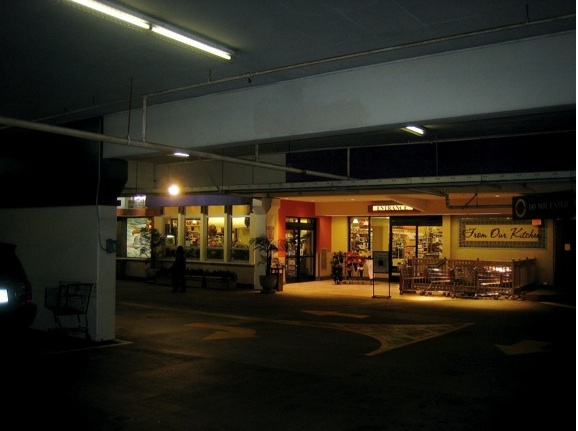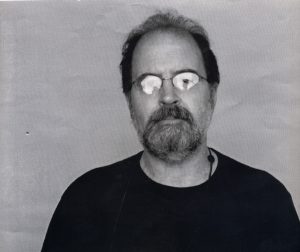Dry refrigerated air. Warm bright light. Colors, vivid and organic. Symmetrical stacks of oranges(3 kinds), grapefruit(2 kinds), lemons, limes, apples (5 kinds) and vegetables: lettuce (4 kinds); squash(3 kinds); tomatoes (2 kinds), green onions and scallions. Bushels of carrots, glistening with moisture, in open cooler cases looking as if they had just been plucked from the earth. This is just what you see when you walk in the door. Deeper inside can only be described as The Yellow Brick Road for Foodies. Around every corner there is a new avenue of colorful, beautifully arranged things to consume: milk, butter, cream, cottage cheese, eggs, yogurt: all coolly waiting in organized martial columns, many different kinds of each. Roasts, steaks, filets, chickens, turkeys, hamburger (3 grades), red, pink, brown, flesh tones, whole fish and, if you like, filleted or in chunks; pink, gray or white. Boulevards of frozen foods and ice cream, peeking out of their shelves, stacked morgue-ishly, from behind glass doors. Canyons of canned fruit and vegetables and soups and coffee and soft drinks. Dog food and cat food: packaged with cuddly appeal. (Do the animals automatically feel better if the owners feel better about what they’re feeding their pets?) Inside their packaging, waiting, wrapped in eye-catching, sometimes heart-tugging design: rice, pasta, cereal and all the condiments, crowding each other for look-at-me-first space.
The dry goods section is the Vegas Strip of any supermarket. Although two thirds of the stuff you find in a supermarket is edible in some fashion, dry goods that perform so many different, non-comestible, cleaning functions such as washing (dishes, clothes and bodies), mopping, wiping, waxing, polishing and brushing can’t have the usual constraints of food packaging. Hence, this section of the market has a much more fanciful feel to it. The wacky ergonomics of detergent bottles certainly borrow from Disney, if not Gehry.The only part of the market that is somewhat off-putting is the baked goods section. This is because there is no expected odor.The comforting fragrance of baked dough, such a strong nurturing childhood cue, has been trapped in cellophane and extracted from the supermarket experience. Its absence is tactile.
The first L.A. supermarket that got my attention me was Gelsons in Encino. It was 1970 and I was visiting a friend in the Valley, still trying to make up my mind about moving here. It was a hot day and there was that gritty smog taste in my mouth – the constant companion of an L.A. summertime drive. I got out of my sweltering car, onto the baking tarmac and entered the market. What a relief.
Once inside, what instantly registers is the air temperature. Air conditioning, prominent so as to prevent spoilage, is a prerequisite for the full-on supermarket experience. Obviously, in winter this is not a factor, but in the summer months, the temperature difference with the outside is always dramatic. I’m sure it’s metabolic, the thing that makes me energized in low temperatures, and I have always loved the dark, absolutely refrigerated air in a New Orleans bar on a hot summer day, a cool quiet restaurant a the big city on a humid night and certainly the crisp coolness of a spacious high-ceilinged supermarket with its friendly lighting, and its quilt of primary food colors; colors that are imbedded in our subconscious and, when associated with food, signal texture and taste that triggers emotion and memory.
My current favorite supermarket is burrowed underground in Marina Del Rey. It is a Gelsons and its interior is not unlike any other Gelsons. However, this market shines out from the gloom at the end of an underground parking lot, a warmly lit subterranean cave that feels as if it belongs down the Rabbit Hole in Alice In Wonderland. It exists totally apart from the sunny California world a few feet above it.
 On the other end of this underground bunker is a Sports Chalet with its own red sign and pool of warm light spilling out of its entranceway. One can feel the possibility of an underground city down here, cool and smog-less.
On the other end of this underground bunker is a Sports Chalet with its own red sign and pool of warm light spilling out of its entranceway. One can feel the possibility of an underground city down here, cool and smog-less.
A man named Michael Cullen started the super market idea early in the 20th century, introducing us to King Kullen (with a K, for Kong, as in King) in New York City. The traditional grocery store model, where clerks moved around behind counters to fetch customer orders off shelves, had been in existence for hundreds if not thousands of years. But the early 20th century experiments in self-service by the A & P (Atlantic and Pacific) and Piggly Wiggly grocery companies showed that great efficiencies could be realized by letting the customer choose his/her own food, collecting it in a basket on wheels or over the arm, and only deal with store employees when paying at the checkout counter.Grocery companies resisted the idea up until the Depression, but the economies of scale brought cost savings to the cash-strapped consumer of the day. The supermarket concept gestated through WW II and, when the great post-war suburban expansion began in the United States, there was demand for a high volume, automobile-friendly, one-stop household shopping experience.
Returning from Eastern Europe several years ago, I was struck by the difference between the markets here and in Czechoslovakia, where I had been staying for a week. In the early 1990’s, the Czech Republic, as it is now known, was still putting itself back together after the 1989 Velvet Revolution and, so, still very much had the trappings of a communist-ruled Iron Curtain country. That is to say that a great deal of economic dysfunction could still be seen in a tattered public infrastructure as well as the scarcity of food staples in most grocery stores. Although modeled on the familiar American self- service plan, the market that I visited almost every day for a week did not have anywhere near the amount of food on their shelves that is the norm here. There would be a small box of turnips, a few potatoes and possibly a few bushels of carrots in the vegetable section. As the week went by, tired looking onions might replace the turnips, but the potatoes would stay, looking the worse for wear. The butcher might have a couple of anemic looking chickens along side a block of cheese of indeterminate origin. The cheese might stay, but the chickens would disappear within a couple of days. There might be paper towels (or not) but no toilet paper in the paper goods section. Most items seemed to be placed with no thought of looking appetizing or attractive and were often haphazardly grouped.
Places where the economy had failed so utterly to bring basic functionality to its citizens was a new discovery. South America and Mexico, where I had traveled as well, and, certainly being poor, still appeared to feed and clothe their people with some sense of industry. Despite the often-extreme poverty, there was energy and life in the markets and shops. In this formerly communist society, on the other hand, people were so conditioned to man-made scarcity that they seemed robbed of, or at least did not exhibit, any industry or pride. The staff and customers of the market were not starving or homeless, but the atmosphere of this place was forlorn and tinged with a bitter shared resignation. The grocery store was probably the perfect metaphor for the gray near-death life that the Russian regime had, for 25 years, imposed upon these people.
The suburban development in mid 20th century America encouraged supermarket design that would accommodate thousands of square feet of shopping space which, when surrounded by the usual prairie-like parking lot, gave these places their outsized feeling, crammed with a profusion of abundance that have made Lucky Stores and Ralphs Markets further examples (as if we need more) of America’s unique contribution to the industry of man. They symbolize our victory over starvation. They also symbolize the corporatizing of the food chain and the death of the family farm. Wherever possible, supersizing grocery stores has been copied, as it brings so much ease to the task of feeding ourselves. Success has been total with the hegemony of the giant agriculture and grocery conglomerates, but the system is being challenged more and more. It now seems that people want to know their food better, to know that it hasn’t been grown four thousand miles away and processed or “enhanced” in a giant factory before it’s hermetically sealed and then driven or flown to look so beautiful in our markets. Witness the Slow Food movement or the Whole Foods market chain with its “grown locally” labels and plethora of organic food.
To people from other parts of the planet (think Darfur or North Korea), this organized riot of color, texture, shape, size, taste and four-kinds-of-everything must mystify them as much as their desolation stumps us. The failure of these people to master their own destinies creates a wide chasm across which we view each other. In America, we are now quibbling over how we want our food delivered, while in many dark corners of the planet, people arise every morning wondering if they will get enough of it to simply survive another day. We know how we got to this point. We’re just beginning to learn why other people haven’t. Besides symbolizing the necessity and lust for food, the supermarket highlights American creativity and creativity-run-amok. It also represents a system that needs to be more equally shared around the globe. In the meantime, I will still catch my breath every time I enter one of these gustatory cathedrals. It may be as close to god as I’ll ever feel.
————–
About the Author:
Peter’s major at Antioch is finishing with a degree of some sort before dementia and/or death occur. He has had a fine life in the performing arts as a musician, where no adult behavior was required, well into his middle age.At that point, he segued into producing music for advertising, which, although more adult in some ways, was mostly a well-paid exercise in suffering fools (at times) gladly. Peter is married to a fine adult, Darlene Chan, and also has a wonderful son of whom he is very proud and who is becoming an adult a lot faster than his father was able to.


